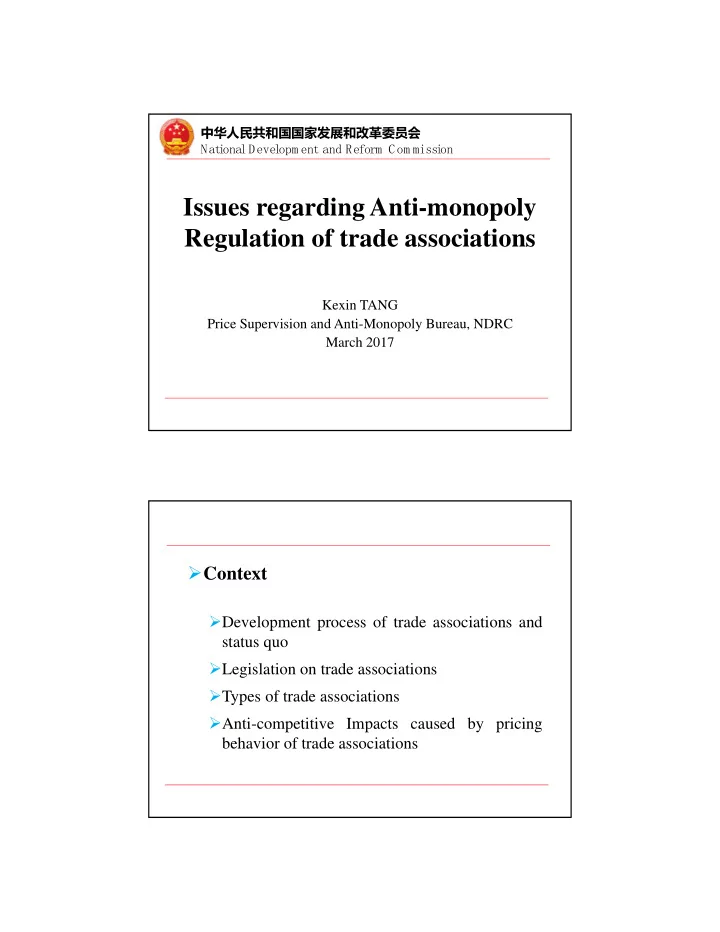

中华人民共和国国家发展和改革委员会 Nat i onal Developm ent and Reform Com miss i on Issues regarding Anti-monopoly Regulation of trade associations Kexin TANG Price Supervision and Anti-Monopoly Bureau, NDRC March 2017 Context Development process of trade associations and status quo Legislation on trade associations Types of trade associations Anti-competitive Impacts caused by pricing behavior of trade associations
Context 1. Development process of trade associations and status quo Taking initial shape in the process of marketization Great contribution to development of economy and society 2. Legislation on trade associations National level: “Administrative Regulation on Registration of Civil Society Organisations” a. No legal definition for “trade association” b. No specific law which defines the rights and obligations of a trade association Local level: there are local regulations/provisions regarding trade associations a . A general definition for “trade association”, emphasis on “same trade/ industry”, “autonomous” and “non-profit” b. Mainly based on “Administrative Regulations on Registration of Civil Society Organisations”, focusing on registration management of trade associations; putting forward the priciples for good practise of trade associations Context 3. Types of Trade Associations a. Transformed from an administrative organ into a trade association, or government-run b. Established as a non-governmental organization, government supported and controlled c. Non-governmental autonomous organization 4. Impacts caused by pricing behaviour of trade associations on competition a. Striking phenomenon: trade associations directly organize operators to reach monopoly agreements b. Considerable indirect impacts from pricing information disclosed by trade associations on competition and market order c. Trade associations become facilitator and beneficiary of improper market intervention imposed by administrative powers
Pricing Behavior Guide of Trade Associations and Status Quo Purposes of the Guide Main contents Main challenges encountered in the drafting process of the Guide About the Guide 1 . The purposes of the Guide a . To facilitate trade associations to ensure compliance management b. To identify trade associations’ practices that have high legal risks, so as to guide the trade associations to cut down wrongdoings that cast negative impacts on competition c.To facilitate AMEAs to identify related conducts of trade associations 2. Main contents of the Guide a . Determining the definition of “trade association” Extending the concept of “same trade/industry”: Same trade/industry + same business model + same research fields b . Regulating the self-discipline of industry Prohibition of Price Monopoly Agreements among operators: fixing or changing price + fixing or changing preferential treatment on price + issuing market indicative price, benchmark price or calculation formula for price and cost + internal disciplinary actions to guarantee the above-mentioned measures
About the Guide c. Regulating information disclosure on price Laying down the basic principles on how to determine the legal risks of price information disclosure by trade associations b. Prohibiting abuse of powers of the industry supervision 3. Major challenges encountered in the drafting process of the Guide a. Legal boundary of information disclosure by trade associations to its members Collecting, analyzing and issuing industrial information are important competence of trade associations Information disclosure by trade associations helps the producers to improve their cognitive abilities on market Communicating price information with / among the association members and other operators within the industry would easily lead to price convergence of operators in the same industry and create a substantial “pricing alliance” b. Legal boundary of information disclosure by trade associations to the public – Information disclosure to the public helps to mitigate information asymmetry between suppliers and buyers – might influence price expectation of the public, and lead to uniformity of commodity prices Several issues that we would like to know : Definition of “Trade Association” in European law How does the EU prevent negative anti-competitive impacts caused by trade associations Examples of EU’s investigations on monopolistic conducts of trade associations
Contact Info : Tel.: +86 10 68502270 Email: tangkx@ndrc.gov.cn jjjfzgzc@126.com Thank you 谢 谢 for your attention!
Recommend
More recommend